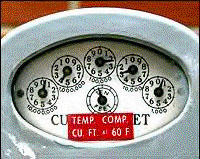By H. JOSEF HEBERT, AP
 Getty Images
Getty ImagesThe government warns that natural gas prices may jump more than 70 percent this fall.
More Coverage:
� Save on Your Bill
� Conserving at Home
--------------------------------------------------------------------------------
(Oct. 12) - Heating bills are headed through the roof, expected to average 50 percent higher this winter for homes that use natural gas. People in parts of the Midwest are likely to pay even more � as much as $1,600 for the winter months if the weather is especially bad.
Utility officials said Tuesday they expect to have plenty of natural gas despite disruptions from two hurricanes. But the utilities have been paying substantially more for the fuel they have been putting in storage, and are likely to face even higher costs this winter.
Those fuel costs account for about 70 percent of what a residential customer pays, although that varies among gas utilities.
How high retail heating costs will be is likely to depend as much on the cold as anything else, with utilities forced to buy more of the expensive gas if demand increases.
"The biggest driver for natural gas bills will be weather," said Roger Cooper, executive vice president of the American Gas Association.
The AGA, which represents gas utilities, warned if there is a colder than normal winter in the Midwest, natural gas could cost homeowners as much as 70 percent more than last season.
Mark Wolfe, who is executive director of the National Energy Assistance Directors' Association, called on Congress to substantially increase the federal low-income energy assistance program to help people who may be unable to pay their higher hearing bills.
Last year, the average gas user nationwide spent about $700 for heat over the winter months, although prices in the Midwest � where people rely heavily on natural gas for home heating � averaged about $950 for the season.
The AGA gave a briefing on the expected winter heating situation in advance of the Energy Department's winter outlook report to be released on Wednesday.
The EIA report also is likely to show soaring heating costs for people who heat their homes with fuel oil. About four of every five homeowners heat with natural gas in the Midwest, compared with 52 percent nationwide. While half of the homes in New England heat with fuel oil, 37 percent in that region use natural gas, according to the AGA.
Paul Wilkinson, an AGA vice president, said despite storm-related production disruption in the Gulf, the industry is on track to reach a "comfortable" level of gas supply in storage at the beginning of November, the start of the heating season. The amount of gas in storage is expected to be above the five-year average, he said.
However, much of that gas was bought by utilities at high prices. The cost of wholesale gas increased last summer because of greater than expected demand by power companies as a result of warm weather. After the hurricanes disrupted 20 percent of the nation's gas production, wholesale prices soared even higher, peaking for a time at $14 per thousand cubic feet, more than double the level of last spring.
Wolfe, who represents state officials who manage the federal low-income energy assistance program, said the working poor will be hit especially hard. At times, people may have to decide whether to pay utility bills or go without food or postpone medical attention, he said.
And, he cautioned, the high energy prices may lead some people to flirt with danger by using their kitchen stoves, space heaters or even candles for warmth, raising a fire risk.
"We have never seen prices so high and increase so quickly," said Wolfe at a news conference with the AGA officials, adding that many people already are strapped because of high gasoline costs.
He said at least $5.1 billion will be needed for the assistance program just to keep up with the demand of last year. "The current funding base of $2.2 billion has been severely eroded by recent price increases," said Wolfe.
The program served about 5 million households last year, and at least another million applicants are expected this winter because of the soaring energy costs, he said.
Cooper said that most states prohibit utilities from shutting off natural gas supplies to residential customers during winter months, although shutoffs can occur when the weather turns warmer if bills are not paid. He said in addition to the government aid programs, the gas utilities are spending $1.7 billion in rate relief for those who cannot pay.
10/12/05



No comments:
Post a Comment